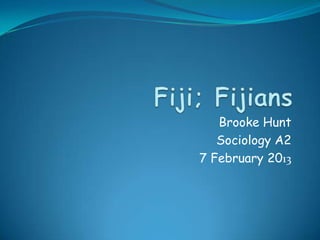
Fiji
- 1. Brooke Hunt Sociology A2 7 February 2013
- 2. History Islands known as Cannibal Islands because Fijians were known as fierce warriors and cannibals. Believed, eating the enemy would let them possess their enemies power. However, Fijians later converted to Christianity and ended cannibalism.
- 3. Land/Climate Located in southwestern Pacific, north of New Zealand More than 300 Islands; 110 inhabited. Humid and tropical climate Rainy season: Nov. to April Annual temp. change: 70 to 86F
- 4. Population & Lang. Three main islands make up the majority of population. English is the official language; Fijian and Hindustani are widely spoken.
- 5. Religion Religion plays a major role in the lives of Fijians Most are Christian; Methodists and Roman Catholics predominate. Indians are either Hindu or Muslim Chinese are either Christian or Buddhist People often celebrate festivals of other religions
- 6. Attitudes Usually generous, friendly, and easygoing. Daily life is relaxed and casual. Community is important; for example, a relative or neighbor can ask for something and it must be given willingly. Although Fijians are peaceful, they remain proud of their cultural heritage and traditions
- 7. Appearance Wear light, casual clothing throughout year Public attire is fairly conservative (No bathing suits, especially for women) Traditional villages, women don’t wear shorts or pants. Everyday clothing for men and women is most often a colorful toga
- 8. Greetings Most common way to say hello is Bula (pronounced “mboola”, meaning health) Formal meetings, they use a handshake, which can last a few minutes, as the greeters continue conversation before letting go. Common to address most people by first name A person related or having a established relationship, may be greeted by that relationship.
- 9. Gestures Tilting head down and Offensive to touch avoiding eye contact while someone’s head speaking shows respect. PDA, even for married Staring = offensive couples are looked down Pointing directly at upon someone while speaking is rude. Standing with hands on hips is seen as aggressive Pointing bottom of ones foot is seen as impolite
- 10. Visiting Remove shoes before Walk in a stooped entering a home position when others are Sitting cross-legged is seated common in a Fijian Visits can last a while home Impolite to refuse A guest sits in place of refreshments honor It is impolite to stand higher than those who sit
- 11. Eating Usually no utensils, but Eat from tin plates and spoons & forks are bowls becoming more common Women & girls usually in urban areas eat after men & boys All meals, cloth is spread Leafy vegetables, tropical on mat-covered floor fruits, seafood, chicken, Sit cross- pork, beef are eaten in legged, pray, pass a bowl Fiji. of water to wash hands (before and after meal)
- 12. Lifestyle Father is head of the Traditional home called home a bure Families large and Furniture is not seen elderly are usually taken much in Fijian cared for by their homes, but many children middle-class families do. Subsistence chores are Dating is usually shared between men and nonexistent in Fijian women culture, but Western influences have changed that in some areas
- 13. The ethnic Fijian man Sports: rugby, soccer, and chooses his own wife and cricket are most popular a ceremony is Handicraft artists make held, followed by a feast masi cloth, bowls, and Funeral practices vary by mats ethnic group Dances are described as Many Fijians mourn for legends and historical 100 days, followed by a events feast Public holidays: New Year’s, Easter, Fiji Day, Christmas, Boxing Day, & a few others
- 14. Society Farming is the key economic activity for most Fijians Most people travel by open-air bus service than taxis & private automobiles because it’s less expensive. Free education for grades 1 – 8th; Many schools operated by religious groups Little disease; water is safe; life expectancy rates are rising steadily
- 15. Symbols The National Flag is a symbol of Fiji The Fijian coat of arms consists of two Fijian warriors on either side of a shield A whales tooth is used as a symbol of peace
- 16. Values The community is valued above all else Money is a value Fijians value discipline
- 18. Works Cited "Facts about Fijian Culture." Captain Cook Cruises. Captain Cook Cruises, 15 Jun 2011. Web. 3 Feb 2013. "Fiji." CultureGrams Online Edition. ProQuest, 2013. Web. 3 Feb 2013. Library, Robinson. "The Robinson Libraray." . Robinson, 12 Jan 2012. Web. 3 Feb 2013.